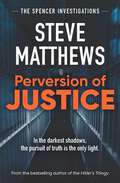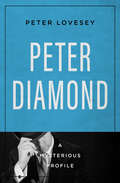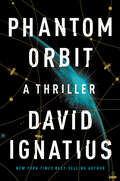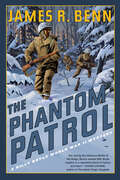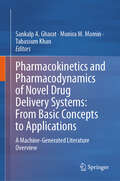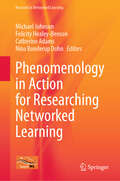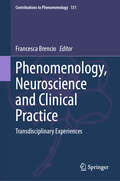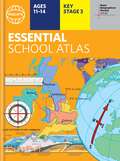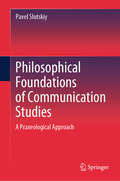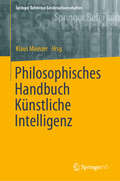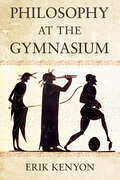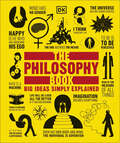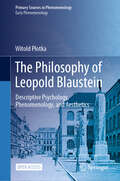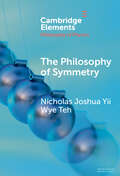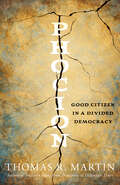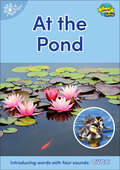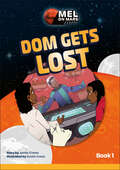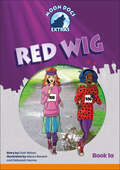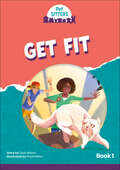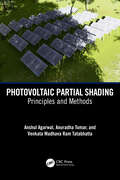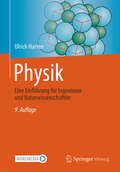- Table View
- List View
Perversion of Justice
by Steve MatthewsIn the darkest shadows, the pursuit of truth is the only light.&‘Brilliant … a captivating new voice in Australian crime fiction&’In the scorching summer of 2004, a working-class Sydney suburb erupts in turmoil when Percy Fullwood, a respected local, is accused of a heinous crime by his own family. As the media frenzy ignites, Detective Bruce Spencer leads a high-profile raid, branding Percy guilty before trial. Enter Diane Spencer, Bruce's wealthy and determined sister, who refuses to accept the verdict. Teaming up with enigmatic lawyer Otto, Diane launches a daring quest for justice. While Percy languishes in prison, Diane and Otto risk everything to uncover the truth, delving deep into the labyrinth of corrupt officials and Sydney's dark underbelly. Against a backdrop of political intrigue and personal vendettas, the investigators navigate treacherous waters to unravel the conspiracy. As they dig deeper, Diane and Otto realise that the powerful forces at play will stop at nothing to protect their web of secrets. Will truth triumph against the odds, or will the Spencer team be consumed by the darkness they seek to defeat?
Peter Diamond (Mysterious Profiles #18)
by Peter LoveseyThe chief of the Bath murder squad finally gets his say in this revealing mini-autobiography of the star character in the “superb series” (Louise Penny, #1 New York Times–bestselling author of the Inspector Gamache novels).Reader, you’re about to get the truth, the inside story, the stuff Peter Lovesey never discovered. . . .Longtime police detective Peter Diamond has kept his mouth shut ever since learning that some author had the nerve to use his stellar career as a model for a supposedly fictional mystery series. At first, he consulted a solicitor, but it was explained to him that the case would be expensive. So now he’s going to tell his own story, from his days as a dyslexic schoolboy to his start as a humble copper with the Met in the 1980s, and the many difficult cases he brilliantly cracked in Bath. It’s past time to hear from the real detective behind the “impatient, belligerent, cunning, insightful, foul, laugh-out-loud funny” character, as Louise Penny put it—and who gave Peter Lovesey his Diamond Dagger Award and Mystery Writers of America Grand Master status. “Lovesey is a wizard at mixing character-driven comedy with realistic-to-grim suspense.” —The Wall Street Journal“The enduring draw of the Peter Diamond books derives both from the beguiling Bath cityscape and the brusque character of Diamond himself.” —NPR“What’ll it be today? A knotty puzzle mystery? A fast-paced police procedural? Something more high-toned, with a bit of wit? With the British author Peter Lovesey, there’s no need to make those agonizing decisions, because his books have it all.” —The New York Times Book Review
Phantom Orbit
by David IgnatiusDavid Ignatius is known for his uncanny ability, in novel after novel, to predict the next great national security headline. In Phantom Orbit, he presents a story both searing and topical, with stakes as far-reaching as outer space. It follows Ivan Volkov, a Russian student in Beijing, who discovers an unsolved puzzle in the writings of the 17th century astronomer Johannes Kepler. The puzzle holds untold consequences for space warfare. Volkov continues his secret work back home in Moscow. The years pass, and they are not kind. After the loss of his son, a prosecutor who'd been too tough on corruption, and Russia's invasion of Ukraine, Volkov makes the fraught decision to contact the CIA. He writes: Satellites are your enemies, especially your own.... Hidden codes can make time stop and turn north into south. If you are smart, you will find me. With this timely novel, Ignatius addresses our moment of renewed interest in space exploration amid geopolitical tumult. Phantom Orbit brims with the author's vital insights and casts Volkov as the man who, at the risk of his life, may be able to stop the Doomsday clock.
The Phantom Patrol (A Billy Boyle WWII Mystery #19)
by James R. BennAn investigation into a gang of Nazi-affiliated art thieves leads Billy Boyle and his comrades directly into the line of fire at the catastrophic Battle of the Bulge.Winter 1944: Months after the Liberation of France, ex-Boston cop Billy Boyle finds himself in a Paris reeling from the carnage it has endured but hopeful that an end to war is in sight. When Billy finds a rare piece of artwork after a tense shoot-out in the Père Lachaise Cemetery, he thinks it could be connected to the Syndicat du Renard, a shadowy network of Nazi sympathizers known to be smuggling stolen artwork out of France.Trailing the Syndicat, Billy discovers that someone with a high level of communications clearance—someone in the Phantom regiment of the British Army—may be using his position to aid the thieves. Billy, determined to stop the abettor, heads up to the frontlines where he experiences a last-ditch battle against overwhelming odds. There, the ruinous Battle of the Bulge unfurls in the Ardennes Forest. Can Billy and his team survive the bracing onslaught and return the stolen artwork to its rightful protectors?
Pharmacokinetics and Pharmacodynamics of Novel Drug Delivery Systems: A Machine-Generated Literature Overview
by Sankalp A. Gharat Munira M. Momin Tabassum KhanThe book delves into the intricate realm of pharmacokinetics and pharmacodynamics as they apply to modern advancements in drug delivery systems. It offers a comprehensive exploration of novel drug delivery methods, with a particular focus on nanoparticles and nanocarriers. The absorption, distribution, metabolism, and excretion processes of nanoparticles are extensively examined. It also covers various evaluation models, spanning from preclinical to clinical, aimed at assessing the effectiveness and safety of nanoparticles in drug delivery. It also covers the integration of Artificial Intelligence and Machine Learning in pharmacokinetics and pharmacodynamics, showcasing how these cutting-edge approaches can enhance our understanding of drug behavior and optimize therapeutic outcomes. It serves as a comprehensive guide, highlighting the fusion of traditional pharmacological concepts with contemporary drug delivery systems and innovative technologies, all in the pursuit of refining medical treatments and patient care and is a valuable resource for academicians, researchers, and pharmacologists.
Phenomenology in Action for Researching Networked Learning (Research in Networked Learning)
by Michael Johnson Catherine Adams Nina Bonderup Dohn Felicity Healey-BensonThis book champions phenomenology’s place in networked learning theory, research, and practice. The book illuminates and showcases something of the powerful richness, depth, and novel insights offered by phenomenological perspectives on human experience to invoke a fundamental rethinking of experience in networked learning. It also signals the broader learning technology community to acknowledge and engage with these perspectives. The editors and authors have collaborated to bring a renewed focus upon the human facet of networked learning. As our world becomes more digitally enmeshed, infiltrated, and contested, the need to investigate and convey, at maximum fidelity, the lived experience of learners, teachers, and other stakeholders in education becomes paramount. Through phenomenological inquiry, we disclose the complex dance between the human and the technical, spotlighting how individuals engage, navigate, and find meaning within virtual yet embodied landscapes. This approach suitably honours the complexity, profundity, and ethicality of human existence in our evolving digital ecologies. The first section, “Phenomenological Perspectives in Researching Networked Learning” lucidly explains phenomenology and some of its potential affordances. The second section, “Practising Phenomenological Research in Networked Learning”, explicates the tangible practice of phenomenological research into specific phenomena: chapters sample of a select range of studies that also indicate the kind of insights such research can bring to networked learning. The concluding section presents two chapters that denote novel and arresting, “Critical Phenomenological Perspectives on Networked Learning”. Together, these final chapters demonstrate the type of radical challenge that phenomenology can bring to the field, refreshing even networked learning’s most basic conceptions and practices. With this book, we open a space for anyone who wishes to join us in the wonderful, inspiring, and challenging application of phenomenology within the field of networked learning.
Phenomenology, Neuroscience and Clinical Practice: Transdisciplinary Experiences (Contributions to Phenomenology #131)
by Francesca BrencioThis book offers fundamental insights into three main fields of education and expertise: phenomenology, neuroscience, and clinical practice. The richness and pluralism of the contributions aim to overcome the reductionist and dualistic approach to mental health and shed new light on clinical practice. Designed as both an education tool for mental health professionals, and a theoretical investigation for philosophers on the use of phenomenology in clinical practice, this book highlights the need for a new direction on mental health, and more general, on human wellbeing. This volume aims to fill the gap between philosophers and mental health professionals on an educational level, in a space unique in its open and transdisciplinary approach. It appeals to students and researchers but also very much to professionals and clinicians in the field.
Philip's Essential School Atlas (Philip's World Atlas #25)
by Philip's Maps"An excellent world atlas. Very illuminating, good colours, clear texts...good glossary and, last but not least, up-to-date". Amazon customer review- The ideal school atlas for Key Stage 3 pupils and Scotland's National Qualifications., 11-14 years old- All updated for 2024 specifically to meet curriculum needs- Specially focused 16-page UK and Ireland section- Comprehensive 62-page world section includes thematic maps on the environment, climate change, people, quality of life, and energy- Published in association with the Royal Geographical SocietyPhilip's RGS Essential School Atlas has been specially created for lower-secondary geography students (11-14 year olds). The maps have been carefully designed to be uncluttered and easy to read, containing specially selected place names and detail. A clear set of symbols and scale information accompanies every map, with a useful introductory section covering basic atlas skills, including aerial photographs and satellite images to further explain particular features on the maps. Latitude and longitude co-ordinates are included in the index, alongside figure-letter references. Fully up-to-date, the atlas includes detailed regional maps, charts and satellite images of Europe, Italy, the Middle East, China, Japan, Kenya, USA, Brazil, and the Arctic and Antarctica. It also focuses on areas of special interest for students of geography, such as Japan's volcanoes and earthquakes, and conservation in Kenya.Philip's RGS Essential School Atlas is ideal for special project work and is available in both hardback and paperback editions.
Philip's Essential School Atlas (Philip's World Atlas #25)
by Philip's Maps"An excellent world atlas. Very illuminating, good colours, clear texts...good glossary and, last but not least, up-to-date". Amazon customer review- The ideal school atlas for Key Stage 3 pupils and Scotland's National Qualifications., 11-14 years old- All updated for 2024 specifically to meet curriculum needs- Specially focused 16-page UK and Ireland section- Comprehensive 62-page world section includes thematic maps on the environment, climate change, people, quality of life, and energy- Published in association with the Royal Geographical SocietyPhilip's RGS Essential School Atlas has been specially created for lower-secondary geography students (11-14 year olds). The maps have been carefully designed to be uncluttered and easy to read, containing specially selected place names and detail. A clear set of symbols and scale information accompanies every map, with a useful introductory section covering basic atlas skills, including aerial photographs and satellite images to further explain particular features on the maps. Latitude and longitude co-ordinates are included in the index, alongside figure-letter references. Fully up-to-date, the atlas includes detailed regional maps, charts and satellite images of Europe, Italy, the Middle East, China, Japan, Kenya, USA, Brazil, and the Arctic and Antarctica. It also focuses on areas of special interest for students of geography, such as Japan's volcanoes and earthquakes, and conservation in Kenya.Philip's RGS Essential School Atlas is ideal for special project work and is available in both hardback and paperback editions.
Philosophical Foundations of Communication Studies: A Praxeological Approach
by Pavel SlutskiyThis book explores the philosophical foundations of communication studies, suggesting that communication phenomena extend beyond the scope of traditional scientific methods. It argues that communication, deeply intertwined with human behavior, cannot be fully comprehended through empirical methods alone. The book presents an epistemological alternative to empiricism in communication studies—an alternative rooted in the praxeological perspective. Drawing from the principles of rationalism, it proposes that conclusions about communication can be deduced from a priori theoretical truths, rather than empirical evidence. This book is a crucial resource for scholars in both philosophy and communication studies.
Philosophisches Handbuch Künstliche Intelligenz
by Klaus MainzerDas Handbuch schlägt die Brücke von der Grundlagenforschung zum Orientierungswissen. Es greift damit die Bildungs- und Ausbildungsziele der bundesweiten MINT-Initiative auf, die Mathematik (M), Informatik (I), Naturwissenschaft (N) und Technik (T) als fachübergreifendes Schlüsselwissen für technisch-wissenschaftlich gestützte Gesellschaften versteht. Additives Wissen und Ausbildung in getrennten Disziplinen der Mathematik, Informatik, Naturwissenschaft und Technik reichen aber nicht aus. In der Künstlichen Intelligenz wachsen diese Disziplinen mit den Human- und Sozialwissenschaften zusammen. Zunächst sollen die Grundlagen der KI-Forschung methodisch und begrifflich geklärt werden. Philosophie wird als Grundlagenforschung verstanden, die logisch und methodisch die Prinzipien von Wissenschaft und Technik untersucht. Daher handelt es sich um ein „Philosophisches Handbuch“ (in diesem Fall der KI) und nicht um eine Bindestrich-Philosophie, also ein Handbuch der Philosophie einer Einzelwissenschaft. Denken und Wissen selber und das Selbstverständnis der Menschen verändern sich durch KI grundlegend.
Philosophy at the Gymnasium
by Erik KenyonPhilosophy at the Gymnasium returns Greek moral philosophy to its original context—the gyms of Athens—to understand how training for the body sparked training for the mind. The result is an engaging inroad to Greek thought that wrestles with big questions about life, happiness, and education, while providing fresh perspectives on standing scholarly debates.In Philosophy at the Gymnasium, Erik Kenyon reveals the egalitarian spirit of the ancient gym, in which clothes—and with them, social markers—are shed at the door, leaving individuals to compete based on their physical and intellectual merits alone. The work opens with Socratic dialogues set in gyms that call for reform in character education. It explores Plato's moral and political philosophy through the lens of mental and civic health. And it holds up Olympic victors as Aristotle's model for the life of happiness through training.
The Philosophy Book (DK Big Ideas)
by DKGet to grips with the concepts that shaped the way we think about ethics, politics, and our place in the universe.Explaining the big ideas and groundbreaking theories of key philosophers clearly and simply, The Philosophy Book is the perfect one-stop guide to philosophy and the history of how we think. Untangling knotty theories and shedding light on abstract concepts, entries explore and explain each complex idea with easy-to-follow explanations and innovative visuals. Explore the history of philosophy, from ancient Greece and China to today, and find out how theories from over 2,000 years ago are still relevant to our modern lives. Follow the progression of human ideas and meet the world's most influential philosophers – from Plato and Confucius through René Descartes and Mary Wollstonecraft to Ludwig Wittgenstein and Judith Butler.Dive into this phenomenal philosophy book to discover:-An accessible guide to philosophy, covering every major school and movement throughout history.-The clear and detailed text explains the most groundbreaking philosophical concepts and theories ever devised, while bold illustrations and pull-out quotes bring each idea to life.-Fully revised and updated to cover any developments in the field over the last 5–10 years.-Biography and context boxes place each idea in its wider historical, cultural, and social context.Your Philosophical Questions, Simply ExplainedIf you thought it was difficult to learn philosophy and its many concepts, The Philosophy Book presents the key ideas in a clear layout. Find out what philosophers thought about the nature of reality and the fundamental questions we ask ourselves: What is the meaning of life? What is the Universe made of? And work your way through the different branches of philosophy, such as metaphysics and ethics, from ancient and modern thinkers.The Big Ideas SeriesWith millions of copies sold worldwide, The Philosophy Book is part of the award-winning Big Ideas series from DK. The series uses striking visuals and engaging writing, making big topics easy to understand.
The Philosophy of Leopold Blaustein: Descriptive Psychology, Phenomenology, and Aesthetics (Primary Sources in Phenomenology)
by Witold PłotkaThis is an open-access book which is devoted to rediscovering the early history of phenomenology in confrontation with the legacy of Franz Brentano by discussing Leopold Blaustein’s philosophy. It offers a unique perspective on the history of the phenomenological movement by presenting the development of Blaustein’s theory. Blaustein was a philosopher educated by Kazimierz Twardowski in Lvov, but he also held research stays in Freiburg im Breisgau (where he studied under Edmund Husserl) and in Berlin (where he met Carl Stumpf). Blaustein’s work is usually classified as phenomenology yet some scholars question this by claiming that Blaustein was radically critical of Husserl’s phenomenology. This text addresses these divergent opinions by claiming that Blaustein was both a descriptive psychologist and a phenomenologist. Moreover, the book shows that these two motives were intertwined in Blaustein’s writings and require a reference to other traditions such as the Gestalt theory of Stumpf, and the humanistic psychology of Dilthey. This volume examines sources, context, and applications of the methods used by Blaustein in his original philosophy. It appeals to philosophers, especially phenomenologists, epistemologies, and historians. The more specialized chapters are also relevant to historians of the phenomenological movement and the Brentanian tradition.
The Philosophy of Movement: An Introduction
by Thomas NailAn influential thinker distills years of work on the philosophy of movement into one accessible account Why are city dwellers worldwide walking on average ten percent faster than they were a decade ago? Why are newcomer immigrant groups so often maligned when migration has always constituted civilization? To analyze and understand the depth of the reasons, Thomas Nail suggests that it serves us well to turn to a philosophy of movement. Synthesizing and extending many years of his influential work, The Philosophy of Movement is a comprehensive argument for how motion is the primary force in human and natural history. Nail critiques the bias toward stasis at the core of Western thought, asking: what would a philosophy that began with the primacy of movement look like? Interrogating the consequences of movement throughout history and in daily life in the twenty-first century, he draws connections and traces patterns between scales of reality, periods of history, and fields of knowledge. In our age of rapid movements shaped by accelerating climate change and ensuing mass global migration, as well as ubiquitous digital media, Nail provides a contemporary philosophy that helps us understand how we got here and how to grapple with these interlocking challenges. With a foreword by philosopher Daniel W. Smith, The Philosophy of Movement: An Introduction is a must-read for scholars and students not only of philosophy but also history, anthropology, science and technology studies, mobility studies, and other fields across the humanities and social sciences.
The Philosophy of Symmetry (Elements in the Philosophy of Physics)
by null Nicholas Joshua Yii Wye TehThis Element is a concise, high-level introduction to the philosophy of physical symmetry. It begins with the notion of 'physical representation' (the kind of empirical representation of nature that we effect in doing physics), and then lays out the historically and conceptually central case of physical symmetry that frequently falls under the rubric of 'the Relativity Principle,' or 'Galileo's Ship.' This material is then used as a point of departure to explore the key hermeneutic challenge concerning physical symmetry in the past century, namely understanding the physical significance of the notion of 'local' gauge symmetry. The approach taken stresses both the continuity with historically important themes such as the Relativity Principle, as well as novel insights earned by working with contemporary representational media such as the covariant phase space formalism.
Phocion: Good Citizen in a Divided Democracy (Ancient Lives)
by Thomas R. MartinThomas R. Martin recounts the unmatched political and military career of Phocion of Athens, and his tragic downfall Phocion (402–318 BCE) won Athens&’s highest public office by direct democratic election an unmatched forty-five times and was officially honored as a &“Useful Citizen.&” A student at Plato&’s Academy, Phocion gained influence and power during a time when Athens faced multiple crises stemming from Macedonia&’s emergence as an international power under Philip II and his son Alexander the Great. Following Athens&’s defeat by Macedonia, Phocion unsuccessfully sought mild terms of surrender. Oligarchy was imposed on democratic Athens, and more than twelve thousand &“undesirable&” Athenians were exiled. When the oligarchic regime was overthrown and the exiles returned, dispossessed Athenians took out their volcanic anger on Phocion, who throughout his career had often been a harsh critic of the citizens&’ political decisions. His inflammatory rhetoric contributed to the popular conclusion that he lacked a genuine sense of belonging to the community he wished so desperately to preserve. When he was eighty-four, the Athenians convicted him of treason and condemned him to die by hemlock. In this fresh biography, Thomas R. Martin explores how and why Phocion ultimately failed as a citizen and as a leader. His story offers unsetting lessons for citizens in democracies today.
Phonic Books Dandelion World Extras Stages 8-15 (Phonic Books Beginner Decodable)
by Phonic BooksLearn how to read with Dandelion World Extras decodable books for beginner readers.Dandelion World Extras Stages 8-15 are first reader books by Phonic Books which introduce children to a few letters and sounds at a time. This pack of 16 books is aimed at children in Pre-K to 1st Grade who are learning to read, teaching different letter patterns through a series of non-fiction stories. Two books for every stage provide phonics practice while offering different stories and encouraging independent reading from the start of their journey. Each stage introduces new letters and sounds while supporting any previously taught phonic letters or sounds and high-frequency words or sight words. For example: Unit 1: Sam and Tim (s, a, t, i, m)Unit 2: Sit on Top! (n, o, p)Unit 3: In the Bag (b, c, g, h)Unit 4: In the Van (d, e, f, v)This beginner reader series features: - A pack of 16 decodable books each containing a story with different phonic letters and sounds.- Reading material aimed at children aged 4-6.- CVCC words (consonant-vowel-consonant-consonant). Four letters producing distinct sounds when blended that are simple to sound out. An example of this is gift, g-i-f-t.Each 12-page book contains: - ‘How to Use This Book’ guidance page with ‘This book introduces’ text box, including information about the new sounds introduced, sounds learned from previous books, high-frequency words, and important notes on the sound.- Story pages (numbers 1-6) with one line of text per page. - Game Intructions. - Photocopyable game page.What is phonics?Phonics is a way of teaching children to read by understanding the sounds that individual letters make and blending them to make a word. Children can learn to read using this skill to decode new words. Phonic Books specializes in decodable, systematic books supporting this structured literacy instruction.
Phonic Books Dandelion World VCe Spellings (Phonic Books Beginner Decodable)
by Phonic BooksPhonic Books Dandelion World Split Vowel Spellings introduces split vowel spellings in a gradual way.This series comprises six fully decodable non-fiction books which introduce the spellings a-e, e-e, i-e, o-e, and u-e and is aimed at children in Reception to Year 2 learning their split vowel spellings and who love to read non-fiction.Dandelion World Split Vowel Spellings complements any systematic phonics programme and can be used in any sequence.Book 1: a-eBook 2: e-eBook 3: i-eBook 4: o-eBook 5: u-eBook 6: All spellingsThe accompanying spelling and comprehension activities can be found in Phonic Books Dandelion World Split Vowel Spellings Activities.
Phonic Books Mel on Mars: Decodable Books for Older Readers (CVC, Consonant Blends and Consonant Teams) (Phonic Books Catch-Up Decodable Readers)
by Phonic BooksLearn how to read with these decodable Phonic Books for older readers.Phonic Books Mel on Mars are older reader books which introduce children to a few letters and sounds at a time. The pack of 12 decodable books is aimed at older children in the very early stages of reading and in need of support, teaching different letter patterns through a series of stories.Dedicated books in each stage break down phonics practice while offering different stories, encouraging independent reading from the start for ages 9-12 or KS2/Years 5 and 6. It starts at at CVC level and introduces adjacent consonants and consonant digraphs, with gentle progression throughout the set.For example:Books 1, 2 & 3: CVC, CVCCBooks 4 & 5: CCVC and -ed, CCVCCBook 6: ‘ch’ and ‘tch’Book 7: ‘sh’This catch-up reader book series features: - A pack of 12 decodable books each containing a story with different phonic letters and sounds.- Each unit introduces new letters and sounds through sounding them out (sat, s - a - t).- Reading material aimed at older children who need support with their reading.- CVC, VCC, CVCC, CCVC, and CCVCC words, introducing adjacent consonants, consonant diagraphs and suffixes -ed and -ing.Each 16-page book contains:- Reading practice/vocabulary- Contents page- Story pagesWhat is phonics?Phonics is a way of teaching children to read through understanding the sounds that individual letters make and blending them to make a word. Children can learn to read using this skill to decode new words. Phonic Books specialises in decodable, systematic books supporting this structured literacy instruction.
Phonic Books Moon Dogs Extras Set 2: Decodable Phonic Books for Older Readers (CVC Level, Alternative Consonants and Consonant Diagraphs) (Phonic Books Catch-Up Decodable Readers)
by Phonic BooksLearn how to read with these decodable Phonic Book activities for older readers. Moon Dogs Extras Set 2 Activities are older reader books which introduce children to a few letters and sounds at a time. The activity book accompanies Moon Dog Extras Set 2 and is perfect for older children in the very early stages of reading and in need of support, teaching different letter patterns through a series of activities. Three books in each stage provide phonics practice while offering different stories, encouraging independent reading from the start. It starts at CVC level and introduces adjacent consonants and consonant digraphs, with gentle progression throughout the set. For example: Books 1a, 1b and 1c: CVC Books 2a, 2b and 2c: VCC, CVCC Books 3a, 3b and 3c: CCVC Books 4a, 4b and 4c: CCVCC This catch-up reader series features: - Activities to practice previously taught letter patterns in Moon Dogs Extras Set 2. - Reading material aimed at older children who need support with their reading. - CVC, VCC, CVCC, CCVC, and CCVCC words, introducing adjacent consonants and consonant diagraphs. Each 12-page book contains: - Introduction to the activity book. - A variety of activities to practice phonics materials taught in the accompanying book Moon Dogs Extras Set 2. - Photocopiable pages. What is phonics? Phonics is a way of teaching children to read through understanding the sounds that individual letters make and blending them to make a word. Children can learn to read using this skill to decode new words. Phonic Books specializes in publishing decodable, systematic books supporting this structured literacy instruction.
Phonic Books Pet Sitters: Decodable Phonic Books for Older Readers (CVC, Alternative Consonants and Consonant Digraphs, Alternative Spellings for Vowel Sounds - ai, ay, a-e, a) (Phonic Books Catch-Up Decodable Readers)
by Phonic BooksLearn how to read with these decodable Phonic Books for older readers.Phonic Books Pet Sitters are older reader books that introduce children to a few letters and sounds at a time. The pack of 12 decodable books is aimed at older children in the very early stages of reading and in need of support, teaching different letter patterns through a series of stories. Dedicated books in each stage break down phonics practice while offering different stories, encouraging independent reading from the start for ages 9-12 or Grades 4-6. It starts at at CVC level and introduces adjacent consonants and consonant digraphs, with gentle progression throughout the set.For example:Books 1 & 2: CVC, CVCC, CCVCBooks 3: CCVCCBook 4: sh, ch, tch, thBook 5: ck, ng, qu, wh, le, -edThis catch-up reader book series features: - A pack of 12 decodable books each containing a story with different phonic letters and sounds.- Each unit introduces new letters and sounds through sounding them out (sat, s - a - t).- Reading material aimed at older children who need support with their reading.- CVC, VCC, CVCC, CCVC, and CCVCC words, introducing adjacent consonants, consonant diagraphs and suffixes like -ed.Each 16-page book contains: - Reading practice/vocabulary- Contents page - Story pagesWhat is phonics?Phonics is a way of teaching children to read through understanding the sounds that individual letters make and blending them to make a word. Children can learn to read using this skill to decode new words. Phonic Books specializes in decodable, systematic books supporting this structured literacy instruction.
Photovoltaic Partial Shading: Principles and Methods
by Anuradha Tomar Anshul Agarwal Venkata Madhava TatabhatlaThis text comprehensively discusses the modeling of photovoltaic (PV) modules, PV array interconnections, multi-level inverters, distributed maximum power point tracking techniques, and static and dynamic PV array reconfiguration techniques. It gives a step-by-step procedure for hardware validation of the partial shading mitigation techniques.This book: Focuses on the impacts and mitigation techniques related to partial shading problems associated with PV systems. Presents a step-by-step guide for addressing partial shading problems in PV systems. Covers methods like array reconfiguration through Tom-Tom puzzle pattern and Arrow Sudoku pattern. Presents hardware validation of the partial shading mitigation techniques. Elaborates static and moving shading conditions in a detailed manner. It will serve as an ideal reference text for graduate students and academic researchers in the fields of electrical engineering, electronics and communication engineering, environmental engineering, and renewable energy.
Physik: Eine Einführung für Ingenieure und Naturwissenschaftler
by Ulrich HartenDie Grundlagen der Physik - kurzweilig, anschaulich und präzise.Über 400 Abbildungen und zahlreiche Beispiele aus dem Alltag fördern das Verständnis für physikalische Zusammenhänge. Die im Dialog mit Studenten erarbeitete Didaktik wird durch das ansprechende zweifarbige Layout unterstützt und erleichtert das Lernen. Über 300 Verständnisfragen und Übungsaufgaben mit Antworten im Anhang regen zu selbständiger Beschäftigung mit der Thematik an. Das Werk ist nicht nur für die Prüfungsvorbereitung hervorragend geeignet. Aufgrund des ausführlichen Sachverzeichnisses ist es auch als Nachschlagewerk zu empfehlen.Auf seiner Internetseite bietet der Autor interessante Links, Animationen und ergänzend zu den einzelnen Buchkapiteln Verständnisfragen mit kommentierten Lösungen zum Download an.In der 9. Auflage wurde das Buch aktualisiert und überarbeitet. Zudem wurden zahlreiche Videos in das Buch eingebracht.„Ein trockenes Fach"...ist das Urteil der meisten Studenten über die Physik. Mit umso mehr Vergnügen werden Sie dieses Lehrbuch zur Hand nehmen.
Physik unserer Umwelt: Die Atmosphäre
by Thomas Wagner Walter RoedelDas vorliegende Lehrbuch bietet eine Einführung in die Physik der Atmosphäre, wie sie im Rahmen der Umweltphysik gelehrt wird. Zuerst wird dem Leser die Funktionsweise des Systems Atmosphäre verständlich gemacht. Dazu werden Themen wie Strahlungs- und Energiehaushalt, atmosphärische Dynamik, Zirkulationen, Niederschlagsbildung und der Wasserkreislauf behandelt. Zudem werden die umweltrelevanten Aspekte der Meteorologie und der Atmosphärenphysik herausgearbeitet. Hierzu dienen unter anderem eine ausführliche Darstellung von Diffusions- und Transportprozessen sowie zahlreiche Abschnitte über das Verhalten von Spurenstoffen, mit Schwerpunkt auf strahlungsrelevanten Spurengasen und Aerosolen. Eine Diskussion von Klima-Entwicklungen und deren Bewertung rundet den Inhalt ab und bietet damit einen umfassenden Überblick über das Thema. Änderungen gegenüber der 5. Auflage betreffen insbesondere die letzten 3 Kapitel. Einerseits wurde in den letzten 6 Jahren eine Vielzahl neuer Forschungsergebnisse verfügbar. Andererseits hat sich in diesem Zeitraum auch der Zustand unseres Planeten weiter dramatisch verändert. In der neuen Auflage werden hierzu die neuesten verfügbaren Messdaten und Studien berücksichtigt. Das Buch wendet sich ebenso an Studierende der Physik und der Geowissenschaften wie an Wissenschaftler(innen) und Lehrer(innen), die sich für ihre berufliche Arbeit eine Einführung in die atmosphärische Physik und in die Umweltmeteorologie wünschen. Ein umfangreiches Register ermöglicht das schnelle Auffinden eines Themas, die große Zahl von Quellen- und Literaturangaben erleichtert den Zugang zu weiteren Informationen.
